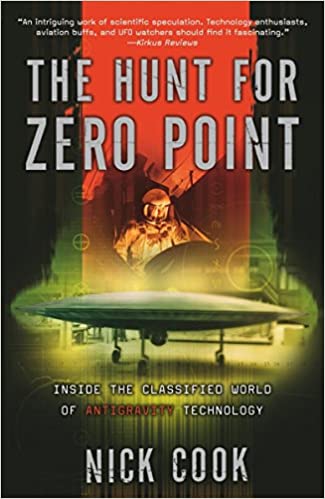
In an effort to get a little distance from hardcore politics and history, I recently reviewed a book on the counterculture in the ’70’s and a great book on Bigfoot. Now comes a book on government research into antigravity and the “flying saucer” phenomenon.
“The Hunt For Zero Point – Inside The Classified World Of Antigravity Technology”, by Nick Cook, is a walk through a different side of UFO research. Cook presents us with a wandering tale of his global travels interviewing scientists and inventors that are not chasing aliens, but are performing serious experiments in shielding objects from the effect of gravity.
Cook seems as puzzled as the reader, sent around the world by a mysterious scientist named “Markus” on leads to uncover the roots of this research. And Cook is no slouch. Cook worked as an aviation editor for the nuts-and-bolts “Jane’s Defense Weekly”, the authoritative military affairs journal. In such a role, he was very familiar with aircraft design, but what Cook found was something very, very different.
As I wrote, Cook is not hunting extraterrestrials, he is seeking earthbound yet mysterious technology.
Some of the leads include publications from the 1950’s that examine the state of electrogravitics systems. These publications promised speedy travel, mechanical wonders and free energy. It’s no surprise that, when the technology appeared achievable, these materials were suppressed.
With every interview hinting where he should look next, we see some results of the tech put into current use.
This includes the modern B-2 bomber with positive and negative charges that allow the plane to cut through the atmosphere. Electrostatic field generating techniques allowed the huge aircraft to “shed weight”, hinting at the first conventional application of antigravity technology.
We see the development of saucer aircraft in the form of the Canadian “Avro” vehicle, a project that was said to have been canned, -but…
The trail heats up when Cook goes to explore the possible origin of antigravity research – the hidden tunnels used by the Nazis to develop secret weapons. This is where horrific slave labor was used to construct the first Nazi versions of cruise missiles – The V-1 and V-2 rockets.
Cook and his guide travel deep into mines in Poland, formerly occupied by the Nazis, and view structures that actually appear to have been test beds for saucer aircraft. In fact, one huge cement ring held up by pylons exactly resembles the one used by the Canadian Avro saucer.
The Nazis were masters at expanding existing mine-shafts, connecting them into massive manufacturing plants for secret weapons. It appears that before the Red Army arrived on the scene, the Americans had been able to spirit away tons of documents and machinery. And with that treasure, went thousands of Nazis that would go to work in America or be hidden in a secret global network.
It is believed that it was these Nazis, who built the American space program, also worked on hidden, parallel projects.
Most of those deep black projects have been shuttled into private companies, like Lockheed, shielding them from public and Congressional scrutiny.
“The Hunt For Zero Point” is no loopy theory book. It is the work of a competent journalist seeking one of our deepest, hidden industrial secrets. The book was published in 2001, and with 20 years of experimenting, the technology has likely gone much further.
There is no small wonder that the Navy has released video of fighter jets chasing unknown craft performing spectacular maneuvers. In a CNN interview last year, I saw “Bill Nye The Science Guy” tell the host that “One branch of the military was chasing another”. Nye, who claimed to have worked with “Area 51” scientists, is convinced we are witnessing man-made technology.
“The Hunt For Zero Point” comes very close to proving just that.
For more information, see the May 9 2016 issue of “The New Yorker”.
There’s a great article on the Nazi tunnel complex in Poland, as well as the revelation that these cavernous workshops may have housed Nazi saucer technology.
The article can be read at this link:
https://www.newyorker.com/magazine/2016/05/09/searching-for-nazi-gold
-John Titus

